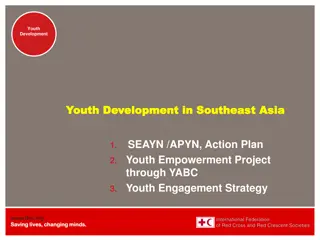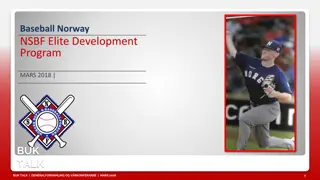Elk Grove Village Youth Baseball 2014 Skills & Concepts for Ages 6-8
Youth baseball program emphasizing fun, action, and skill development for Tee Ball players. Key concepts covered include base running, defense, offense, and various practice topics to enhance players' overall experience.
Download Presentation

Please find below an Image/Link to download the presentation.
The content on the website is provided AS IS for your information and personal use only. It may not be sold, licensed, or shared on other websites without obtaining consent from the author.If you encounter any issues during the download, it is possible that the publisher has removed the file from their server.
You are allowed to download the files provided on this website for personal or commercial use, subject to the condition that they are used lawfully. All files are the property of their respective owners.
The content on the website is provided AS IS for your information and personal use only. It may not be sold, licensed, or shared on other websites without obtaining consent from the author.
E N D
Presentation Transcript
ELK GROVE VILLAGE YOUTH BASEBALL 2014 Skills & Concepts for ages 6-8
COMMON PURPOSE Create a positive experience for the children. Create a desire for the children to want to play again the following year. Dr. Darrell Burnett, Certified Sports Psychologist specializing in Youth Sports and member of the Little League International Board of Directors Since Tee Ball is the ENTRY level of the youth sports process, what kids experience will have quite an impact on whether they want to continue in youth sports process. The issue is this that we want kids' entry level experience to be pleasant. What's pleasant to kids? Just watch them. FUN and ACTION are the keys. And, even in the early stages, if they learn some skills it will add to the fun.
KEY CONCEPTS Base running o Names of bases o How to circle bases o Understanding where to run after a hit is made (hitters and runners) o Running through 1st base o The concept of a force out
KEY CONCEPTS Defense o Names of defensive positions o Knowing where to stand to field a position o Understanding the goal of getting an out o Catching a ball Holding a glove Moving glove to the ball o Throwing a ball Grip Proper throwing technique o The concept of tagging a player out o The concept of a force out o Recognition that there are 3 outs per inning o Covering a base of responsibility
KEY CONCEPTS Offense o Understanding the goal of getting a hit (safe vs. out) o How to properly hold a bat o Proper hitting stance o The technique of a short compact swing o Understanding contact points Pull, Middle, Oppo o Understanding hitting terminology Ground balls, fly balls, line drives Single, double, triple, home run, grand slam o Understanding the concept of an inning o Understanding there are 3 strikes and 4 balls in an at bat
PRACTICE TOPICS Practice Topics o Warm ups o Pre game/practice talk o Playing catch o Fielding ground balls o Hitting o Covering bases on defense o Converting a force out at 2nd & 3rd base o Pitching & Catching o Post game/practice talk
PRACTICE OVERVIEW Equipment List Topic Time Type # of kids Warm Ups 10 mins Entire Team All 1. 2. 3. 4. 5. 6. 7. Hitting Tee Hitting Net Bucket of balls Catchers gear Helmets Bats 2 Coaches Pre Talk 5 mins Entire Team All Throwing/Catching 25 mins 3 groups 3-4 Fielding grounders 25 mins 3 groups 3-4 Hitting 25 mins 3 groups 3-4 Manager Choice 25 mins Manager Choice Manager Choice Post Talk 5 mins Entire Team All
PRACTICE TIPS Coaches should arrive to the field and be ready to go 10-15 minutes before practice. Time is of the essence. Be prepared for practice. Teams play the way they practice. Intensity should be kept at game speed throughout practice. Emphasize hustle on & off the field. Practices should be conducted with a sense of urgency. Spend the first few practices teaching your players how practices are going to be structured and what is expected of them. Early in the season this will have to reinforced often. Try to keep practices fun and challenging. Have a short talk with your team before and after practices and games.
PRACTICE - WARM UPS (10 MINUTES ENTIRE TEAM) Key Point - Players should be part of a routine before practice or a game Run Jog two laps around the bases Basic Plyometrics o Side shuffles Run sliding heel to heel o High Knees Run with knees coming up high to chest o Butt kickers Bring heels into butt with every step o Backward run run backwards o Power skips Skip with power movement of arms o Straight sprints 70 sprint
PRACTICE THROWING AND CATCHING (30 MINUTES) Key Point Playing catch is the single most important defensive drill we can perform. Focus on the fundamental throwing and catching techniques. Each player should throw and catch 50+ balls every practice. Repetition is the key! Pair up kids of about equal skill level o Break technique o Positions 1-2-3 o Bow & Arrow toss then regular catch Start about 15 feet apart and move back 5 after every 10 throws Tips: Younger players are not always ready to play catch. For those kids, have them stand 15-10 feet from the fence and practice throwing into the fence. To practice their catching skills, stand about 10 feet away from them and toss the ball to them to try and catch. Throw 10 balls to the right, 10 to the left, 10 above their waist, and 10 below the waist.
PRACTICE THROWING TECHNIQUE Throwing Grip Use a 4 seam grip. (Fingers across the laces) Hand Breaks This movement should be quick, smooth, and rounded. o Start with the hands in a praying position with thumbs up o Break hands out and turn them over to thumbs down position o Think of this as unzipping a coat 4 seam grip Position 1-2-3 o o Position 1 Stand in the stretch position, hands together & up Position 2 Stand on throwing leg while lifting opposite leg out and up in front of body. (high knee and foot close to ground) Position 3 Break hands, stride forward, & bring arm through for the throw. Finish balanced! Shoulder angles usually dictate the trajectory of the throw. Emphasize to kids to drive their body as they bring the arm through. o Tips: Balance is baseball is HUGE! You cannot over emphasize this point. Encourage the kids to go home and practice standing in position 2 until they can do this comfortably for extended periods of time.
PRACTICE THROWING IMAGES Hand Break Position 1 Position 2 https://encrypted-tbn2.gstatic.com/images?q=tbn:ANd9GcSXO1K6hySDYfixR3CfohEwNahOqwoMlWObUZe2XmN61q1pkHDuH_TSanE4 Lead w/elbow 12 Position 3
PRACTICE CATCHING TECHNIQUE Catching There are 4 main glove positions. The glove should always be receiving the ball in one of these 4 positions depending on where it is. 1. Glove up Thumb right (for right handers) 2. Glove down Thumb left 3. Glove right Thumb down 4. Glove left Thumb up Emphasize moving body to the ball to get in front of a catch whenever possible. Use 2 hands on every catch. Teach kids to assume a bad throw is coming. This will get them ready and make catching good catches that much easier. Tips: Breaking in a glove properly is extremely important. Help kids understand how to work their gloves as they are playing catch.
PRACTICE FIELDING GROUNDERS (30 MINUTES) Key Point Each player should be able to take 50+ grounders per practice. You don t need to hit the grounders. Stand 15- 20 feet away and toss grounders. Repetition is the key! Fielding Technique Chest up (not down), see what s going on in front of you Charge toward the ball Feet spread out with hands out in front (triangle position, keep left foot out front for right handed throwers) Bare hand over top of glove when right in front of you Always catch the ball out in front of you (for back hand or any position) Pull hands to middle of the body after catching the ball (this drives your momentum towards 1st base) Get feet set underneath and throw to 1st base Follow your throw to 1st base Tips: Teach kids to get their gloves under the ball. Practice throwing balls to the middle, to the backhand, & to the forehand sides. To save time have you can have the kids drop the ball to a bucket after they catch it. 14
PRACTICE FIELDING IMAGES Fielding Position Ready Position 15
PRACTICE HITTING (30 MINUTES) Key Point Each player should be able to take 50+ swings per practice between Tee drills, flip drills, soft toss, & regular pitching. Repetition is the key! Groups of 4 o 1 player Tee drills Regular swings, 1 arm swings o 2 players Flip drills Front flips, rear flips o 1 player Front pitching Soft toss, regular pitching Tips: Constantly talk hitting with your players. Teach them to be aggressive hitters. Assume swing on every pitch and then take when it s a bad pitch.
PRACTICE HITTING TECHNIQUE Stance Feet should be lined up straight. (Draw a line in the dirt if necessary to emphasize this point) Balance Hitters should be balanced (strong athletic stance) both before and after the swing. (Have players hold their position after they complete the swing to emphasize this) Hands Short swings o During drills - Hands should be close to the chest with bat on shoulder. Move hands as if your pulling a rope from over your shoulder. o During BP - Hands should move back or back and up but not back and down. (Bat should be moving at the ball at a slight down angle) Swing - Short compact swings o We are not focusing on loading and striding yet Head Heads should stay still. (Should not be moving forward)
PRACTICE HITTING CONTACT POINTS Pull Middle Oppo Pull Short, Compact
PRACTICE HITTING SWEET SPOT Batters know from experience that there is a sweet spot on the bat, about 17 cm from the end of the barrel, where the shock of the impact, felt by the hands, is reduced to such an extent that the batter is almost unaware of the collision. At other impact points, the impact is usually felt as a sting or jarring of the hands and forearm, particularly if the impact occurs at a point well removed from the sweet spot.























